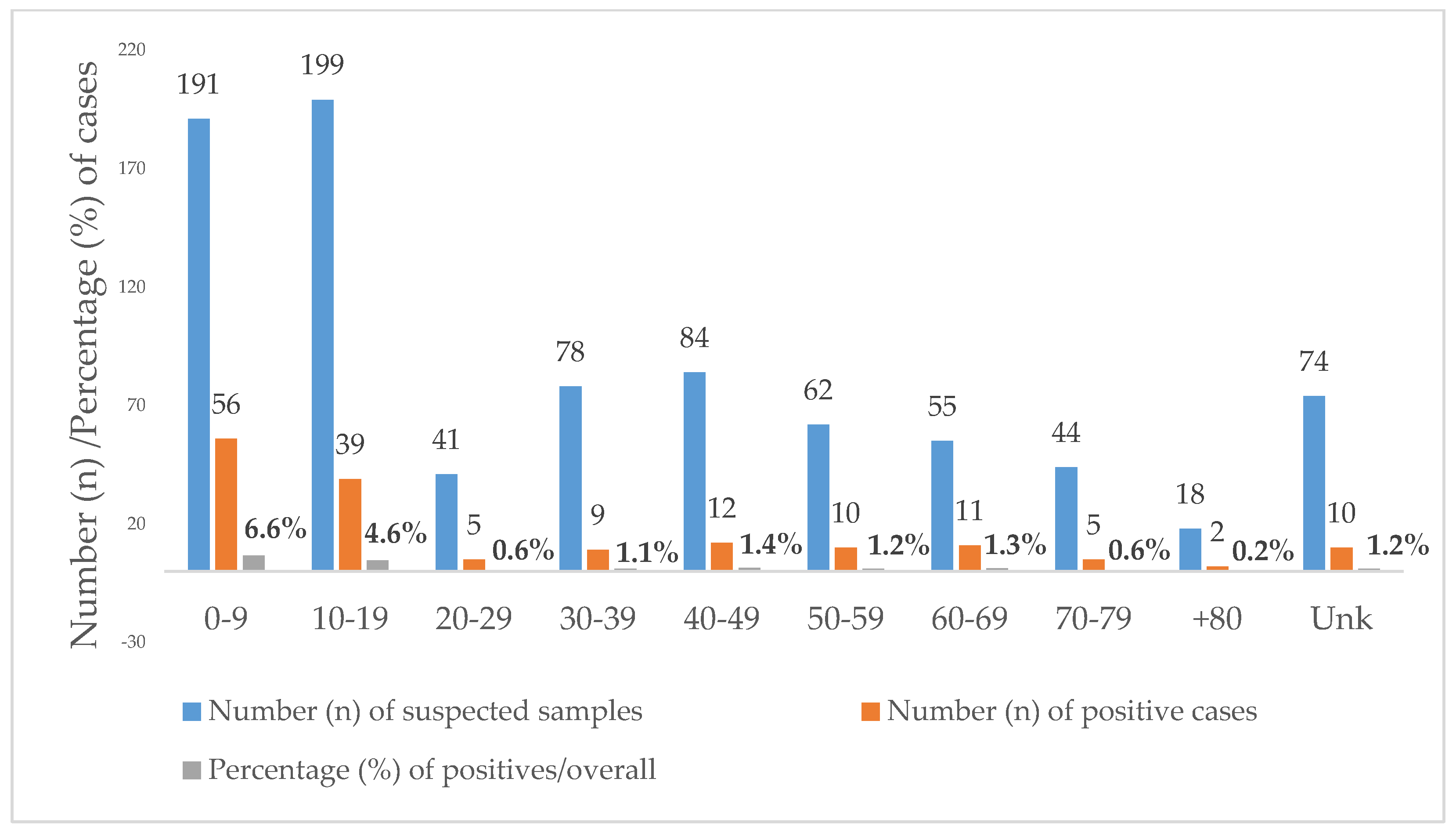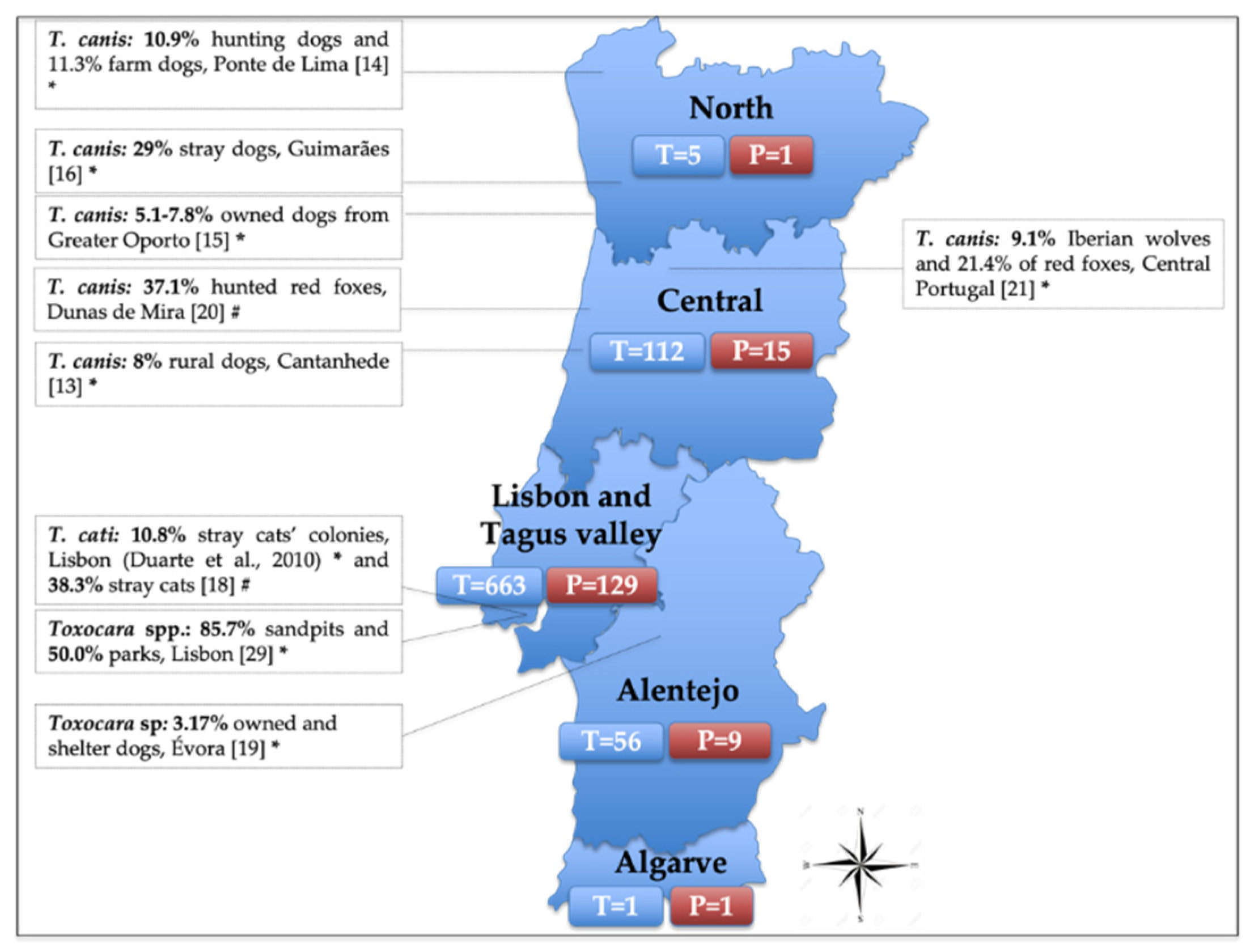Human Toxocariasis in Portugal—An Overview of a Neglected Zoonosis over the Last Decade (2010–2020)
Abstract
:1. Introduction
2. Materials and Methods
Data Analysis
3. Results
3.1. ELISA and CIE
3.2. Distribution along the Decade
3.3. Distribution by Age and Sex
3.4. Distribution by Provenance of the Samples
3.5. Distribution by Medical Specialties
3.6. Features Reported by Clinicians
4. Discussion
5. Conclusions
Author Contributions
Funding
Institutional Review Board Statement
Informed Consent Statement
Acknowledgments
Conflicts of Interest
References
- Moreira, G.M.; Telmo Pde, L.; Mendonça, M.; Moreira, A.N.; McBride, A.J.; Scaini, C.J.; Conceição, F.R. Human toxocariasis: Current advances in diagnostics, treatment, and interventions. Trends Parasitol. 2014, 30, 456–464. [Google Scholar] [CrossRef] [PubMed]
- Parasites—Toxocariasis (Also Known as Roundworm Infection). Available online: https://www.cdc.gov/parasites/toxocariasis/ (accessed on 20 June 2021).
- Nichols, R.L. The etiology of visceral larva migrans: I. Diagnostic morphology of infective second-stage Toxocara larvae. J. Parasitol. 1956, 42, 349–362. [Google Scholar] [CrossRef] [PubMed]
- Despommier, D. Toxocariasis: Clinical aspects, epidemiology, medical ecology, and molecular aspects. Clin. Microbiol. Rev. 2003, 16, 265–272. [Google Scholar] [CrossRef] [PubMed] [Green Version]
- Taira, K.; Saeed, I.; Permin, A.; Kapel, C.M. Zoonotic risk of Toxocara canis infection through consumption of pig or poultry viscera. Vet. Parasitol. 2004, 121, 115–124. [Google Scholar] [CrossRef] [PubMed]
- Baneth, G.; Thamsborg, S.M.; Otranto, D.; Guillot, J.; Blaga, R.; Deplazes, P.; Solano-Gallego, L. Major Parasitic Zoonoses Associated with Dogs and Cats in Europe. J. Comp. Pathol. 2016, 155 (Suppl. S1), S54–S74. [Google Scholar] [CrossRef] [PubMed] [Green Version]
- Chen, J.; Liu, Q.; Liu, G.H.; Zheng, W.B.; Hong, S.J.; Sugiyama, H.; Zhu, X.Q.; Elsheikha, H.M. Toxocariasis: A silent threat with a progressive public health impact. Infect. Dis. Poverty 2018, 7, 59. [Google Scholar] [CrossRef] [PubMed] [Green Version]
- Hotez, P.J. Visceral and ocular larva migrans. Semin. Neurol. 1993, 13, 175–179. [Google Scholar] [CrossRef] [PubMed]
- Hotez, P.J.; Wilkins, P.P. Toxocariasis: America’s most common neglected infection of poverty and a helminthiasis of global importance? PLoS Negl. Trop. Dis. 2009, 3, e400. [Google Scholar] [CrossRef]
- Fan, C.K.; Liao, C.W.; Cheng, Y.C. Factors affecting disease manifestation of toxocarosis in humans: Genetics and environment. Vet. Parasitol. 2013, 193, 342–352. [Google Scholar] [CrossRef] [PubMed] [Green Version]
- Rostami, A.; Ma, G.; Wang, T.; Koehler, A.V.; Hofmann, A.; Chang, B.C.H.; Macpherson, C.N.; Gasser, R.B. Human toxocariasis—A look at a neglected disease through an epidemiological ’prism’. Infect. Genet. Evol. 2019, 74, 104002. [Google Scholar] [CrossRef] [PubMed]
- Martins, S.; Vilares, A.; Júlio, C.; Correia, C.; Ferreira, I.; Reis, L.; Gargaté, J.; Gomes, S.; Ângelo, H. Helminth larval infections—Toxocariasis, cysticercosis and cystic hydatidosis. Acta Parasitol. Port. 2005, 12, 206. [Google Scholar]
- Cardoso, A.S.; Costa, I.M.; Figueiredo, C.; Castro, A.; Conceição, M.A. The occurrence of zoonotic parasites in rural dog populations from northern Portugal. J. Helminthol. 2014, 88, 203–209. [Google Scholar] [CrossRef] [PubMed]
- Mateus, T.L.; Castro, A.; Ribeiro, J.N.; Vieira-Pinto, M. Multiple zoonotic parasites identified in dog feces collected in Ponte de Lima, Portugal-a potential threat to human health. Int. J. Environ. Res. Public Health 2014, 11, 9050–9067. [Google Scholar] [CrossRef] [Green Version]
- Neves, D.; Lobo, L.; Simões, P.B.; Cardoso, L. Frequency of intestinal parasites in pet dogs from an urban area (Greater Oporto, northern Portugal). Vet. Parasitol. 2014, 200, 295–298. [Google Scholar] [CrossRef] [PubMed]
- Silva, V.; Silva, J.; Gonçalves, M.; Brandão, C.; Vieira EBrito, N. Epidemiological survey on intestinal helminths of stray dogs in Guimarães, Portugal. J. Parasit. Dis. 2020, 44, 1–8. [Google Scholar] [CrossRef]
- Duarte, A.; Castro, I.; Pereira da Fonseca, I.M.; Almeida, V.; Madeira de Carvalho, L.M.; Meireles, J.; Fazendeiro, M.I.; Tavares, L.; Vaz, Y. Survey of infectious and parasitic diseases in stray cats at the Lisbon Metropolitan Area, Portugal. J. Feline Med. Surg. 2010, 12, 441–446. [Google Scholar] [CrossRef] [PubMed]
- Waap, H.; Gomes, J.; Nunes, T. Parasite communities in stray cat populations from Lisbon, Portugal. J. Helminthol. 2014, 88, 389–395. [Google Scholar] [CrossRef] [PubMed]
- Ferreira, F.S.; Pereira-Baltasar, P.; Parreira, R.; Padre, L.; Vilhena, M.; Távora Tavira, L.; Atouguia, J.; Centeno-Lima, S. Intestinal parasites in dogs and cats from the district of Évora, Portugal. Vet. Parasitol. 2011, 179, 242–245. [Google Scholar] [CrossRef] [PubMed]
- Eira, C.; Vingada, J.; Torres, J.; Miquel, J. The helminth community of the red fox, Vulpes vulpes, in Dunas de Mira (Portugal) and its effect on host condition. Wildl. Biol. Pract. 2006, 1, 26–36. [Google Scholar] [CrossRef]
- Figueiredo, A.; Oliveira, L.; Madeira de Carvalho, L.; Fonseca, C.; Torres, R.T. Parasite species of the endangered Iberian wolf (Canis lupus signatus) and a sympatric widespread carnivore. Int. J. Parasitol. Parasites Wildl. 2016, 5, 164–167. [Google Scholar] [CrossRef] [Green Version]
- De Savigny, D.H. In vitro maintenance of Toxocara canis larvae and a simple method for production of Toxocara ES antigen for use in serodiagnostic tests for visceral larva migrans. J. Parasitol. 1975, 61, 781–782. [Google Scholar] [CrossRef]
- Rombert, P.C.; Daniel, F.; Trinca, A. Application of ELISA in the diagnosis of parasitic diseases. An. Inst. Hig. Med. Trop. 1982, 8, 39–41. [Google Scholar]
- Nicoletti, A.; Cicero, C.E.; Mantella, A.; Giuliano, L.; Rascunà, C.; Paradisi, V.; Bartoloni, A.; Zappia, M.; Sofia, V. Seroprevalence of Toxocara canis in the city of Catania, Italy. Mediterr. J. Hematol. Infect. Dis. 2019, 11, e2019031. [Google Scholar] [CrossRef]
- Papavasilopoulos, V.; Pitiriga, V.; Birbas, K.; Elefsiniotis, J.; Bonatsos, G.; Tsakris, A. Soil contamination by Toxocara canis and human seroprevalence in the Attica region, Greece. Germs 2018, 8, 155–161. [Google Scholar] [CrossRef] [PubMed]
- Rostami, A.; Riahi, S.M.; Holland, C.V.; Taghipour, A.; Khalili-Fomeshi, M.; Fakhri, Y.; Omrani, V.F.; Hotez, P.J.; Gasser, R.B. Seroprevalence estimates for toxocariasis in people worldwide: A systematic review and meta-analysis. PLoS Negl. Trop. Dis. 2019, 13, e0007809. [Google Scholar] [CrossRef]
- Rostami, A.; Riahi, S.M.; Hofmann, A.; Ma, G.; Wang, T.; Behniafar, H.; Taghipour, A.; Fakhri, Y.; Spotin, A.; Chang, B.C.H.; et al. Global prevalence of Toxocara infection in dogs. Adv. Parasitol. 2020, 109, 561–583. [Google Scholar] [CrossRef] [PubMed]
- Overgaauw, P.; Nijsse, R. Prevalence of patent Toxocara spp. infections in dogs and cats in Europe from 1994 to 2019. Adv. Parasitol. 2020, 109, 779–800. [Google Scholar] [CrossRef] [PubMed]
- Otero, D.; Alho, A.M.; Nijsse, R.; Roelfsema, J.; Overgaauw, P.; Madeira de Carvalho, L. Environmental contamination with Toxocara spp. eggs in public parks and playground sandpits of Greater Lisbon, Portugal. J. Infect. Public Health 2018, 11, 94–98. [Google Scholar] [CrossRef] [PubMed]
- Ferreira, A.; Alho, A.M.; Otero, D.; Gomes, L.; Nijsse, R.; Overgaauw, P.A.M.; Madeira de Carvalho, L. Urban Dog Parks as Sources of Canine Parasites: Contamination Rates and Pet Owner Behaviours in Lisbon, Portugal. J. Environ. Public Health 2017, 2017, 5984086. [Google Scholar] [CrossRef] [PubMed] [Green Version]
- Marques, A.; Rodrigues, A.; Belo, S.; Guedes, M.E. Unusual panuveitis in a child: Toxocariasis associated with ocular myiasis. BMJ Case Rep. 2014, 2014, bcr2014204475. [Google Scholar] [CrossRef] [Green Version]
- Farinha, N.J.; Bartolo, A.; Trindade, L.; Vaz, T.; Monterroso, J.; Areias, J.C.; Santos, N.T. Pericardite aguda na criança. Experiência de 9 anos de um centro de referência terciário [Acute pericarditis in childhood. The 9-year experience of a tertiary referral center]. Acta Med. Port. 1997, 10, 157–160. (In Portuguese) [Google Scholar] [PubMed]
- Holland, C.V. Knowledge gaps in the epidemiology of Toxocara: The enigma remains. Parasitology 2017, 144, 81–94. [Google Scholar] [CrossRef] [PubMed]
- European Scientific Counsel Companion Animal Parasites (ESCCAP). ESCCAP Guideline 01—Worm Control in Dogs and Cats (Sixth Edition—February 2020). Available online: https://www.esccap.org/guidelines/gl1/ (accessed on 4 May 2021).
- Matos, M.; Alho, A.M.; Owen, S.P.; Nunes, T.; Madeira de Carvalho, L. Parasite control practices and public perception of parasitic diseases: A survey of dog and cat owners. Prev. Vet. Med. 2015, 122, 174–180. [Google Scholar] [CrossRef] [PubMed]
- Parsons, J.C. Ascarid infections of cats and dogs. Vet. Clin. N. Am. Small Anim. Pract. 1987, 17, 1303–1307. [Google Scholar] [CrossRef]
- Ma, G.; Holland, C.V.; Wang, T.; Hofmann, A.; Fan, C.K.; Maizels, R.M.; Hotez, P.J.; Gasser, R.B. Human toxocariasis. Lancet Infect. Dis. 2018, 18, e14–e24. [Google Scholar] [CrossRef] [PubMed]
- Mohamad, S.; Azmi, N.C.; Noordin, R. Development and evaluation of a sensitive and specific assay for diagnosis of human toxocariasis by use of three recombinant antigens (TES-26, TES-30USM, and TES-120). J. Clin. Microbiol. 2009, 47, 1712–1717. [Google Scholar] [CrossRef] [Green Version]



| Specialty | Tested Samples (n) | Positive Samples (n) | Positivity (%) |
|---|---|---|---|
| Pediatrics | 275 | 66 | 41.5 |
| Infectiology | 210 | 41 | 25.8 |
| Internal medicine | 62 | 9 | 5.7 |
| Travel medicine | 53 | 6 | 3.8 |
| Hematology | 15 | 6 | 3.8 |
| Pulmonology | 56 | 5 | 3.1 |
| Gastroenterology | 23 | 5 | 3.1 |
| Orthopedics | 32 | 2 | 1.3 |
| Ophthalmology | 18 | 2 | 1.3 |
| Pediatric cardiology | 2 | 2 | 1.3 |
| Clinical pathology | 21 | 1 | 0.6 |
| Rheumatology | 8 | 1 | 0.6 |
| Immunoallergology | 7 | 1 | 0.6 |
| Pediatric surgery | 2 | 1 | 0.6 |
| Neurology | 7 | 0 | 0 |
| Dermatology | 1 | 0 | 0 |
| Nephrology | 1 | 0 | 0 |
| Otorhinolaryngology | 1 | 0 | 0 |
| Psychiatry | 1 | 0 | 0 |
| Radiation oncology | 1 | 0 | 0 |
| Unknown | 50 | 11 | 6.58 |
| Total | 846 | 159 | 18.8 |
| Clinical Manifestations | Tested Samples (n) | Positive Samples (n) | Positivity/Overall (%) |
|---|---|---|---|
| Peripheral blood eosinophilia | 167 | 44 | 5.2 |
| Hepatic nodule(s) | 10 | 6 | 0.7 |
| Hepatosplenomegaly/splenomegaly/hepatomegaly | 13 | 5 | 0.6 |
| Fever | 19 | 5 | 0.6 |
| Elevated level of total immunoglobulin E | 14 | 4 | 0.5 |
| Unilateral uveitis/retinitis/chorioretinitis | 18 | 4 | 0.5 |
| Cough/wheezing | 8 | 3 | 0.4 |
| Abdominal pain | 10 | 3 | 0.4 |
| Pruritus/skin rash/dermatitis | 19 | 3 | 0.4 |
| Convulsions | 1 | 1 | 0.1 |
| Bronchospasm | 4 | 1 | 0.1 |
| Weight loss | 10 | 1 | 0.1 |
| Persistent diarrhea | 21 | 1 | 0.1 |
| Suspected cerebral lesion(s) | 7 | 0 | 0 |
| Emesis | 5 | 0 | 0 |
| Lymphadenopathy | 5 | 0 | 0 |
| Pulmonary eosinophilia | 5 | 0 | 0 |
| Central nervous system infection | 2 | 0 | 0 |
| Habits | |||
| Cat/dog contact | 11 | 2 | 0.2 |
| Undercooked meat consumption | 4 | 1 | 0.1 |
| Soil contact | 2 | 0 | 0 |
Publisher’s Note: MDPI stays neutral with regard to jurisdictional claims in published maps and institutional affiliations. |
© 2021 by the authors. Licensee MDPI, Basel, Switzerland. This article is an open access article distributed under the terms and conditions of the Creative Commons Attribution (CC BY) license (https://creativecommons.org/licenses/by/4.0/).
Share and Cite
Alho, A.M.; Ferreira, P.M.; Clemente, I.; Grácio, M.A.A.; Belo, S. Human Toxocariasis in Portugal—An Overview of a Neglected Zoonosis over the Last Decade (2010–2020). Infect. Dis. Rep. 2021, 13, 938-948. https://doi.org/10.3390/idr13040086
Alho AM, Ferreira PM, Clemente I, Grácio MAA, Belo S. Human Toxocariasis in Portugal—An Overview of a Neglected Zoonosis over the Last Decade (2010–2020). Infectious Disease Reports. 2021; 13(4):938-948. https://doi.org/10.3390/idr13040086
Chicago/Turabian StyleAlho, Ana Margarida, Pedro Manuel Ferreira, Isabel Clemente, Maria Amélia Afonso Grácio, and Silvana Belo. 2021. "Human Toxocariasis in Portugal—An Overview of a Neglected Zoonosis over the Last Decade (2010–2020)" Infectious Disease Reports 13, no. 4: 938-948. https://doi.org/10.3390/idr13040086
APA StyleAlho, A. M., Ferreira, P. M., Clemente, I., Grácio, M. A. A., & Belo, S. (2021). Human Toxocariasis in Portugal—An Overview of a Neglected Zoonosis over the Last Decade (2010–2020). Infectious Disease Reports, 13(4), 938-948. https://doi.org/10.3390/idr13040086








